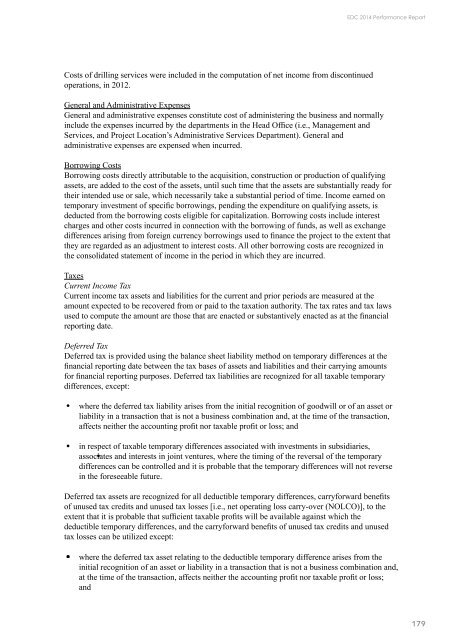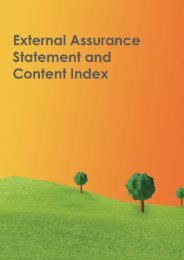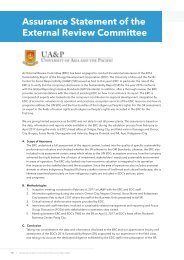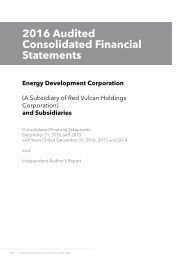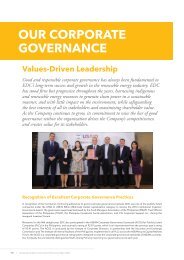EDC 2014 SR (UPDATED)
You also want an ePaper? Increase the reach of your titles
YUMPU automatically turns print PDFs into web optimized ePapers that Google loves.
<strong>EDC</strong> <strong>2014</strong> Performance Report<br />
Costs of drilling services were included in the computation of net income from discontinued<br />
operations, in 2012.<br />
General and Administrative Expenses<br />
General and administrative expenses constitute cost of administering the business and normally<br />
include the expenses incurred by the departments in the Head Office (i.e., Management and<br />
Services, and Project Location’s Administrative Services Department). General and<br />
administrative expenses are expensed when incurred.<br />
Borrowing Costs<br />
Borrowing costs directly attributable to the acquisition, construction or production of qualifying<br />
assets, are added to the cost of the assets, until such time that the assets are substantially ready for<br />
their intended use or sale, which necessarily take a substantial period of time. Income earned on<br />
temporary investment of specific borrowings, pending the expenditure on qualifying assets, is<br />
deducted from the borrowing costs eligible for capitalization. Borrowing costs include interest<br />
charges and other costs incurred in connection with the borrowing of funds, as well as exchange<br />
differences arising from foreign currency borrowings used to finance the project to the extent that<br />
they are regarded as an adjustment to interest costs. All other borrowing costs are recognized in<br />
the consolidated statement of income in the period in which they are incurred.<br />
Taxes<br />
Current Income Tax<br />
Current income tax assets and liabilities for the current and prior periods are measured at the<br />
amount expected to be recovered from or paid to the taxation authority. The tax rates and tax laws<br />
used to compute the amount are those that are enacted or substantively enacted as at the financial<br />
reporting date.<br />
Deferred Tax<br />
Deferred tax is provided using the balance sheet liability method on temporary differences at the<br />
financial reporting date between the tax bases of assets and liabilities and their carrying amounts<br />
for financial reporting purposes. Deferred tax liabilities are recognized for all taxable temporary<br />
differences, except:<br />
where the deferred tax liability arises from the initial recognition of goodwill or of an asset or<br />
liability in a transaction that is not a business combination and, at the time of the transaction,<br />
affects neither the accounting profit nor taxable profit or loss; and<br />
in respect of taxable temporary differences associated with investments in subsidiaries,<br />
associates and interests in joint ventures, where the timing of the reversal of the temporary<br />
differences can be controlled and it is probable that the temporary differences will not reverse<br />
in the foreseeable future.<br />
Deferred tax assets are recognized for all deductible temporary differences, carryforward benefits<br />
of unused tax credits and unused tax losses [i.e., net operating loss carry-over (NOLCO)], to the<br />
extent that it is probable that sufficient taxable profits will be available against which the<br />
deductible temporary differences, and the carryforward benefits of unused tax credits and unused<br />
tax losses can be utilized except:<br />
where the deferred tax asset relating to the deductible temporary difference arises from the<br />
initial recognition of an asset or liability in a transaction that is not a business combination and,<br />
at the time of the transaction, affects neither the accounting profit nor taxable profit or loss;<br />
and<br />
179


